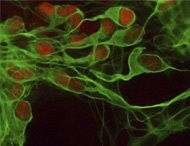Think you have Kennedy's Disease?
Kennedy's Disease (Spinal Bulbar Muscular Atrophy) is an X-linked recessive disorder. A blood test will confirm whether an individual possesses the spinal and bulbar muscular atrophy (SBMA) CAG mutation and therefore is likely to be affected with a predisposition to developing the clinical symptoms associated with Kennedy's Disease.
Some of the clinical symptoms associated with Kennedy's Disease are listed below. See DNA testing labs in the United States.
-
What causes the symptoms that are associated with Kennedy's Disease?
Motor neurons are long nerve cells that extend from your spinal cord to your muscles. These nerve cells fire to make your muscles contract. In KD (Kennedy's Disease) the nerve cells become dysfunctional and eventually die, leaving the muscles unable to contract.
The androgen receptor is a protein that resides inside the nerve cell. Many cells have the androgen receptor protein, but motor neurons have more than most. The binding of testosterone to an androgen receptor somehow causes the onset of the disease. Men are generally affected by KD because they have much higher levels of testosterone than women.
Medical Term | Definition |
|---|---|
Neurological: | |
| Bulbar Signs | The Bulbar muscles are those supplied by the motor nerves coming off the brain stem which control breathing, swallowing, talking and other functions of the throat. Bulbar signs are problems with these functions. |
| Dysphagia | Trouble swallowing. (One of the Bulbar signs.) |
| Intention Tremor | Hand tremors when trying to do something. |
| Normal Babinski | Normal plantar response, ie., when the bottom of the foot is scraped, the toes bend down. An abnormal response would be an upward bending of the toes indicating a problem in the brain itself. |
| Lower Motor Neuropathy | The lower motor nerves are those that run from the spinal cord to the muscles that they stimulate to move. Loss of that nerve leads to weakness and wasting of the muscle. |
| Primary Sensory Neuropathy | Numbness over certain areas. Loss of sensation. |
| Decreased or Absent Deep Tendon Reflexes | When a doctor taps the knee with his hammer there is no response. |
Muscular: | |
| Fasciculations | Twitching of small muscles without purposeful movement, that can be seen through the skin. |
| Cramps | Large muscle spasms. |
| Postural Tremor | Shaky muscles with certain positions. |
| Muscular Atrophy | Wasting and shrinkage of muscles that occurs when the lower motor nerve does not stimulate the muscle adequately. |
| Hypertrophied Calves | Calf muscles that become thicker because of cramps. |
Thoracic: | |
| Gynecomastia | Enlarged breasts. |
Endocrine: | |
| Androgen Deficiency | Loss of masculinizing effect. |
| Estrogen Excess | More of an apparent estrogen effect because of the lost of masculinizing effect. |
Genito-Urinary: | |
| Impotence | Erectile dysfunction. |
| Reduced Fertility | Low sperm count. |
| Testicular Atrophy | Testicles become smaller and less functional. |
Miscellaneous Characteristics: | |
| Late Apparent Onset | Symptoms could become apparent in 20's or 30's, but might not appear until the 60's or 70's. |
| Slow Progression | Near-normal lifespan. |
| Asymmetry of Clinical Signs | Muscles of one side may be more affected than the same muscles on the other side. |
Laboratory: | |
| Elevated Serum Creatine Kinase | Elevation of CPK enzyme in the blood test. Can be confused with the enzyme released during a heart attack. |
| Genetic Test | DNA Test: The Kennedy's Disease gene can be found in the blood by a genetic laboratory test in both affected males and carrier females. Detects CAG triplet repeat expansion in the androgen receptor gene. |



